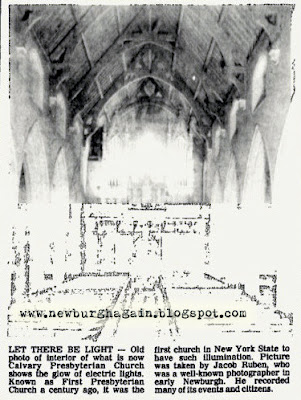First City Church To Use Electricity
The Evening News
March 31, 1984
The First Presbyterian Church here was the first church in New York State to be illuminated by electricity.
“The inspection of the electric light in Newburgh by Thomas A. Edison and others, including prominent gentlemen from New York, Poughkeepsie, and Norfolk, Va.,” is detailed in account in the Daily Journal, dated April 25, 1884.
One of the sites inspected was the church at South and Grand Street, now Calvary Presbyterian Church.
The century-old report came to light as the Historical Society of Newburgh Bay and the Highlands and Central Hudson cosponsored the centennial of the first electricity in Newburgh.
The newspaper listed the visitors, a veritable who’s who of the business and financial leaders of the era. They arrived at 6 p. m., according to the report.
Understanding the electric station in Newburgh was a model one, they wanted a close look. The Poughkeepsie contingent was considering organization of a company there to adopt electric light.
After supper at the “United States Hotel” (later the Palatine), visitors walked to the Montgomery Street electric plant and then to the church.
The lights were turned on and they were praised by the visitors as very fine and brilliant.
The century old account continues: “Mr. Edison remained at the electric building, to converse with Mr. T.C. Conant, the electrician in charge, and other gentlemen.
“Mr. Edison, the great inventor, is a gentleman of ordinary appearance. He dresses in plain black, and wears a square-crown black hat. He is an incessant smoker, and during the animated conversations that he had while here a fragrant Havana contributed toward making him at ease.
“He is a ready conversationalist and when in conversation his countenance is illuminated, and a glance at in convinces the ordinary observer that he is a man of great brain power.”
“That he understands the working of electricity thoroughly goes without saying. He was very highly pleased with his visit, and complimented the gentlemen attached to the station here for the thoroughness of their work. He did not suggest improvements in its conduct, as the requirements had been well met. Other gentlemen spoke very favorably of the workings of the electric light, of its great merit, and the complete manner in which it was controlled and managed.”
The unidentified reporter carefully listed details which remain interesting 100 years later. He concluded:
“The visitors returned to the United States Hotel after their tour of inspection, held a brief conversation among themselves and a few Newburgh gentlemen, with whom they were acquainted, and then took the $.10 boat for Fishkill, the two parties separating at that place, and returning to their respective destinations, New York and Poughkeepsie.”
The Rev. Carlos Lantis, current pastor of Calvary Presbyterian Church, researched the material and church secretary Betty Schoonmaker typed the information from a microfilmed copy to submit the material to the Evening News – helping to recall references of Newburgh and the historic edifice.


